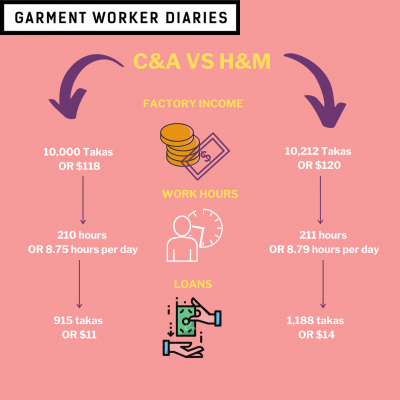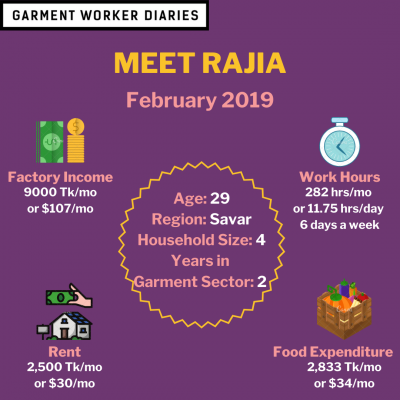MFO and its partner in Bangladesh, SANEM, had a busy 2019 implementing the Garment Worker Diaries project (GWD). We collected a full 12 months of data from 1,300 workers, using the data to track their work hours, earnings, expenses, savings, loans, and transfers. Getting this to run smoothly to generate high-quality data took a lot of work, but we are seeing the benefits as we have focused more of our attention on visualizing and analyzing the data.
The most rewarding part of the data collection process was getting to know the respondents and developing a close and trusting relationship with them. By visiting every worker every week at their homes, they increasingly felt comfortable sharing first-hand accounts of what actually happened inside their factories as well as how keeping a financial diary had changed their day to day lives. Our new YouTube Channel gives you the opportunity to hear directly from the workers about their experience with the project. Among the most important benefits cited by the workers is a growing sense of agency and control over their financial lives. As Sufia explains in this video, keeping detailed records of her work hours and overtime made her realize she was not being properly paid for her overtime and, using her diary as evidence, she felt empowered to talk to the factory management to resolve her situation. Parvin, a single mother of two teenagers, explains in this video how keeping track of the money she transfers to her sons allows her to know exactly how much they are spending and when to give them money. Garment workers commonly rely on credit to purchase food, in her video Shila explains how shopkeepers would often charge her more than what she owed and how she now uses her diary as proof of what she needs to pay. We have heard similar complaints from other garment workers who now often ask shopkeepers to sign their diaries whenever they take on or pay their credit.
The GWD project gave garment workers a voice, a safe place where they could raise their concerns and felt heard. Now that the data collection phase of the study has come to an end, MFO and SANEM are committed to honoring their trust by amplifying their voice and giving visibility to their stories, with the goal of raising awareness and enact change in the living and working conditions of those making our clothes. To this end, in October we launched a new interactive dashboard which has been recently updated to include new data up to September 2019 and an increasing number of matches between workers and brands (to read more about how we are able to link GWD respondents to global brands sourcing from Bangladesh click here).
The dashboard allows users to view the data in a variety of ways, including being able to make regional comparisons and comparisons across brands that source their products from factories in Bangladesh. For instance, if you are interested in what a worker in a factory that supplies Primark with finished garments, you can select Primark from a dropdown menu to see the typical monthly salary of workers in these factories. You can also see their work hours. Or if you are interested in comparing the prevailing monthly wages in different garment producing areas in Bangladesh, you can do that as well.
If you follow our Instagram account, @mfo_workerdiaries you will get daily updates that provide you with a quick look at what is going on in the lives of garment workers in Bangladesh (see examples below). Sometimes we feature one worker, and other times we provide higher-level summaries focused on a brand or a garment producing area. For those who are interested in more in-depth analysis of the data, you can navigate to the reports page. There you will find reports that look at the hourly wage earnings of workers, their experience with wage digitization, and the varying roles of women garment workers within households.



